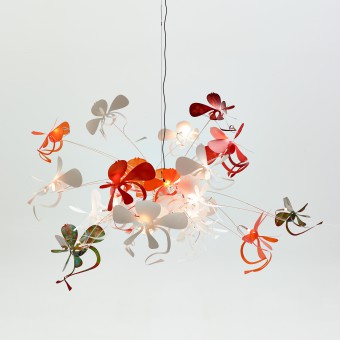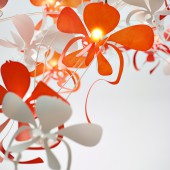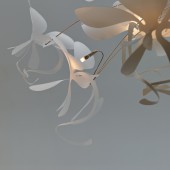
| THE AWARD |
| CATEGORIES |
| REGISTRATION |
| SUBMIT YOUR WORK |
| ENTRY INSTRUCTIONS |
| TERMS & CONDITIONS |
| PUBLICATIONS |
| DATES & FEES |
| METHODOLOGY |
| CONTACT |
| WINNERS |
| PRESS ROOM |
| GET INVOLVED |
| DESIGN PRIZE |
| DESIGN STORE |
| THE AWARD | JURY | CATEGORIES | REGISTRATION | PRESS | WINNERS | PUBLICATIONS | ENTRY INSTRUCTIONS |
Orchid Light by Marc Pascal |
Home > Winners > Design #49111 >Interview |
 |
|
FS: What is the main principle, idea and inspiration behind your design?
MP: To transform flat poly carbonate plastic into a dynamic naturalistic lighting form.
FS: What has been your main focus in designing this work? Especially what did you want to achieve?
MP: Two main directions: making the "flower" into a unique and decorative component, each coloured flower is a "one off". And to resolve the power hub concept: a way to distribute the power to the globes which are housed behind selected flowers.
FS: What are your future plans for this award winning design?
MP: To continue to make these lights for people and to evolve the variety of different compositions and designs using the power hub.
FS: How long did it take you to design this particular concept?
MP: About a year, there were different shapes and varying versions to bring it to the current system.
FS: Why did you design this particular concept? Was this design commissioned or did you decide to pursuit an inspiration?
MP: I designed this concept because it will lend itself to many lights I have yet to design. The principle is that it gives the designer flexibility to arrange globes anywhere within a 700 mm diameter or larger if necessary.
FS: Is your design being produced or used by another company, or do you plan to sell or lease the production rights or do you intent to produce your work yourself?
MP: All the cast components, the dyeing and shaping of the flowers, and the final arrangement and assembly is order done in my studio in Melbourne Australia.
FS: What made you design this particular type of work?
MP: Because I love to design and evolve, this is a natural progression of my work, I designed it to utilize the compact and power full G4 LED globes.
FS: Where there any other designs and/or designers that helped the influence the design of your work?
MP: The earlier version of this light used one Edison Screw globe, the flowers needed to bunch up around the globe to hide the glare, the new light is more minimal and relaxed, and is certainly more poised and dynamic in composition.
FS: Who is the target customer for his design?
MP: People who appreciate bespoke design that want to empower their spaces with my lighting.
FS: What sets this design apart from other similar or resembling concepts?
MP: The modular colouring system, every light is unique, a collaboration between customer and my studio.
FS: How did you come up with the name for this design? What does it mean?
MP: Orchid is an Orchid is an orchid. its a flower light.
FS: Which design tools did you use when you were working on this project?
MP: Illustrator for the shape of the flower. and Rhino for the power hubs, 3D printing. Hand made silicon mould tooling
FS: What is the most unique aspect of your design?
MP: It must be balanced perfectly at the assembly stage so it can rotate freely with air movement in the room, giving it a kinetic property.
FS: Who did you collaborate with for this design? Did you work with people with technical / specialized skills?
MP: Alone in my studio.
FS: What is the role of technology in this particular design?
MP: A little.
FS: Is your design influenced by data or analytical research in any way? What kind of research did you conduct for making this design?
MP: To create the flower form, I experimented with a variety of solutions making a number of versions. The flower is forme cut and rolled around aluminium tube and boiled giving the material a new memory. The flowe5r is sprung around on itsself with added gussets for reinforcement and sprung on two stainless steel wires which are in turn insulated using small diameter silicon tube
FS: What are some of the challenges you faced during the design/realization of your concept?
MP: The usual frustrations.
FS: How did you decide to submit your design to an international design competition?
MP: In the normal way.
FS: What did you learn or how did you improve yourself during the designing of this work?
MP: Lots! I learnt that quality and function must work together, and that there is no compromise for perfection.
FS: Any other things you would like to cover that have not been covered in these questions?
MP: I love it that we follow the clients colour brief, it means we are always refreshed by the constantly changing array of colour and form that passes through our doors.
FS: Thank you for providing us with this opportunity to interview you.
A' Design Award and Competitions grants rights to press members and bloggers to use parts of this interview. This interview is provided as it is; DesignPRWire and A' Design Award and Competitions cannot be held responsible for the answers given by participating designers.
| SOCIAL |
| + Add to Likes / Favorites | Send to My Email | Comment | View Press-Release |





